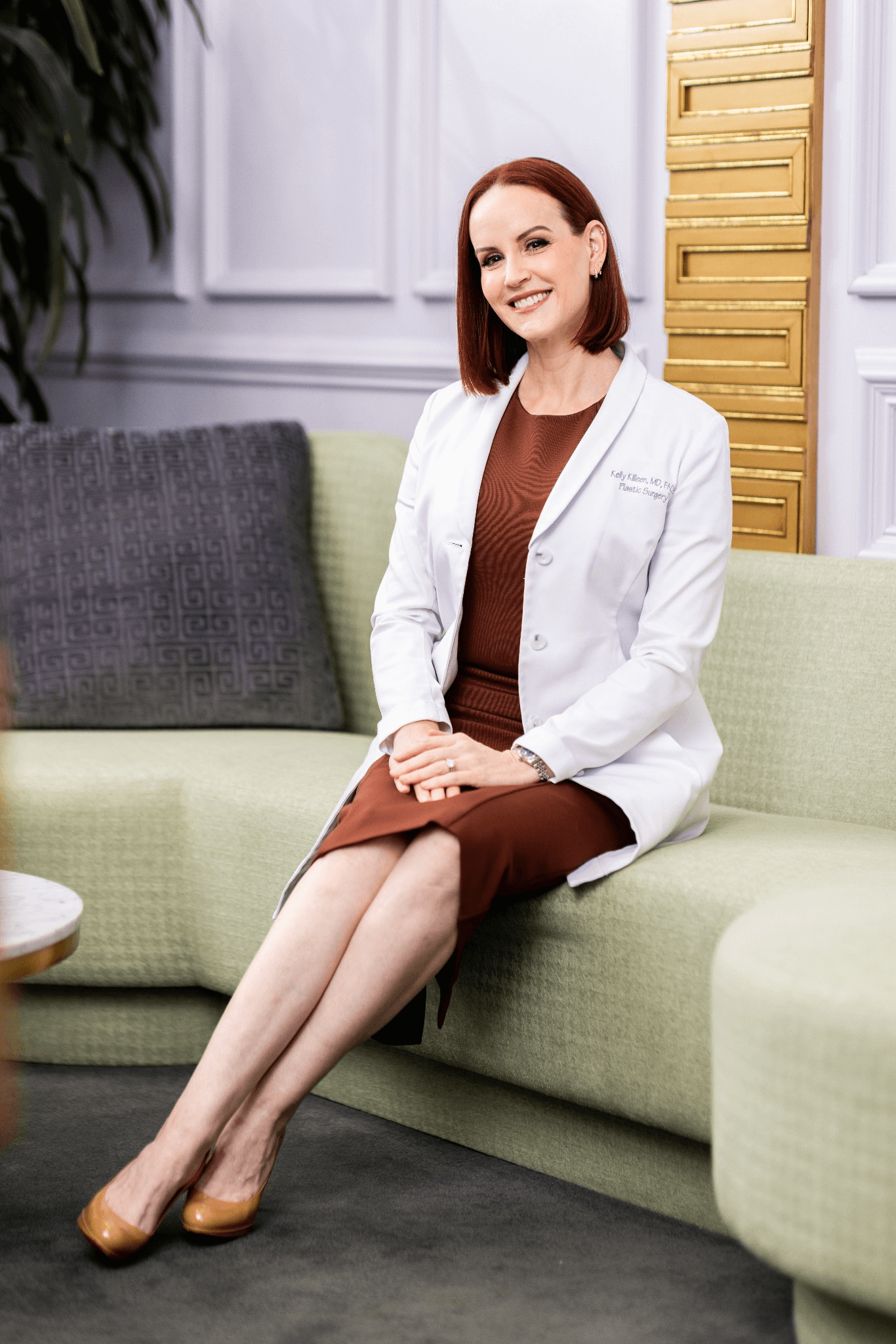Capsular Contracture: Why It Happens and How to Prevent It

After implant surgery, a thin capsule forms as expected. In some patients, it tightens and alters shape or feel. That reality prompts a clear question.
What is a contracted implant?
It refers to the pathological tightening of the scar capsule around a breast implant. This process can increase firmness, distort contour, and sometimes cause pain. Because it affects both augmentation and reconstruction patients, a prompt assessment is important.
Timely evaluation can help clinicians limit progression, maintain pocket position, and reduce revision risk in eligible patients.
At The Practice, Dr. Lisa Cassileth guides a structured pathway for capsular contracture that includes risk stratification, symptom education, tailored prevention, and planned follow-up so you know exactly when to return.
What Is a Contracted Implant?
After implant surgery, the body forms a thin capsule around the breast implant.
In most patients, this layer remains soft and supportive. However, capsular contracture develops when the capsule tightens and compresses the implant. As a result, the breast can feel firm, appear rounded at the edges, or sit higher than expected.
According to the U.S. Food and Drug Administration, capsular contracture is a common local complication that can require additional surgery.
Symptoms vary from weeks to months. You may notice progressive hardness, asymmetry, or a high-riding contour. Risk increases with prior radiation, subclinical infection, hematoma, or a previous contracture.
Capsular contracture can occur after cosmetic breast augmentation or implant reconstruction, so keep regular follow-ups and seek prompt evaluation if you notice firmness, shape change, or pain.
Is capsular contracture dangerous? Mild grades are mainly aesthetic, while higher grades can be painful and may require revision to restore comfort and shape.
Causes of Capsular Contracture
Capsular contracture develops through several pathways. Inflammation, low-grade bacterial activity, surgical technique, implant characteristics, and individual healing responses can all contribute.
Most Common Contributors
Clinically, several recurrent drivers appear across cases, and you can screen for them early during consultation. Some of them are:
- Inflammation: hematoma or seroma increases inflammatory signaling, which may lead to capsule thickening.
- Subclinical infection and biofilm: low-level bacterial presence along the implant pocket can sustain long-term inflammation.
- Implant rupture or silicone gel bleed: extravasated material can prompt a late fibrotic response and visible contour change.
- Trauma: Significant breast injury or pocket disruption can trigger tightening during healing.
- Host factors and genetics: prior contracture, radiation exposure, nicotine use, and individual immune profile increase risk despite careful technique.
A study by PubMed found that patient, surgical, and implant-level variables collectively shape capsular contracture risk, supporting a multifactor model.
Bacterial Contamination And Biofilm
According to a 2016 review in Aesthetic Surgery Journal, microbial biofilms on breast implants sustain chronic inflammation and are a key driver of capsular contracture in susceptible patients.
Biofilm forms when skin bacteria attach to implant or pocket surfaces and build a protective matrix. This layer resists host defenses and common antibiotics.
As a result, low-grade inflammation persists, and the capsule can progressively tighten.
Since contamination often starts during insertion, prevention focuses on careful pocket preparation, limited implant contact, and controlled irrigation.
In addition, surgeons work to minimize hematoma and seroma, which can amplify bacterial load. Early wound care and thoughtful drain use support pocket stability and lower infection risk.
Addressing Myths
Many patients worry that everyday workouts cause capsular contracture.
After medical clearance, routine exercise does not raise risk. In fact, guided movement helps maintain shoulder mobility and comfort.
Concerns about “silicone toxicity” also persist. However, evidence points to fibrosis, low-grade bacterial biofilm, and an individual immune response as the main drivers. Silicone material on its own does not trigger capsule tightening.
Likewise, normal arm motion, sleep position, supportive bras, and air travel do not cause contracture. Problems usually occur due to inflammation, infection, hematoma, or implant rupture, not typical daily activity.
Is Capsular Contracture Dangerous?

Capsular contracture exists on a spectrum. Mild cases feel firm yet look close to normal. However, severe tightening can create a contracted implant with pain and visible distortion.
Because the breast can shift position, screening becomes more difficult, and mammogram alignment or compression may need adjustment.
In most cases, contracture does not threaten overall health, and it does not raise breast cancer risk. However, new swelling, sudden firmness, or fluid build-up should be reviewed promptly, as rare implant-related conditions can initially resemble contracture.
Call your surgeon if you notice:
- Sudden change in shape, height, or hardness.
- Pain with redness, warmth, or fever.
- New swelling or drainage.
- Skin thinning or limited shoulder motion.
- Trouble completing a mammogram.
Symptoms and How to Recognize a Contracted Implant
Capsular contracture often starts subtly. You may feel increased firmness, notice a higher or rounder breast shape, or develop a steady ache. As tightening progresses, distortion becomes more visible and comfort declines.
Common signs you should look out for include:
- Increasing hardness compared with the opposite breast.
- Increasing firmness relative to the other breast.
- Noticeable hardness compared with the untreated breast.
- A breast that feels firmer than its counterpart.
- There is greater firmness on one breast than the other.
Onset varies. Capsular contracture may appear within weeks, but it can also take months or even years to develop. In some patients, changes progress gradually, while in others they accelerate following swelling or infection.
Monitor your breasts with a mirror once a month, keep simple photos under identical lighting, and note any shift in shape or feel. In addition, attend regular follow-ups.
Contact your surgeon immediately if you notice rapid changes, worsening pain, redness, warmth, fever, or sudden swelling.
Prevention Strategies for Capsular Contracture
Prevention starts with careful planning, precise technique, and consistent aftercare. Done together, the steps below lower risk and support long-term comfort.
Before surgery
- Consult a board-certified surgeon with extensive experience in breast implants and reconstruction.
- During consultation, your surgeon will tailor implant size and placement to your tissue quality and any history of radiation.
- Optimize overall health by stopping nicotine, controlling diabetes, and addressing skin conditions.
In the operating room
- No-touch insertion with fresh gloves to reduce contamination.
- Pocket irrigation with antibiotics.
- Careful bleeding control to lower the risk.
After surgery
- Follow your surgeon’s instructions and keep all scheduled checkups.
- Begin range-of-motion exercises only as advised, and perform massages only if specifically recommended.
- Contact your surgeon right away if you notice redness, warmth, swelling, sudden firmness, or drainage.
Dr. Cassileth’s Approach to Prevention
Your visit begins with a focused consultation that reviews health history, tissue quality, and goals. Then she matches implant size and placement to your anatomy. The plan is specific to you.
During capsular contracture surgery, Dr. Cassileth removes both the implant and capsule, either together in an en bloc capsulectomy or separately in a complete capsulectomy.
The capsule is biopsied for biofilm and abnormalities, and the pocket is treated with antibiotic solutions to reduce infection risk. In many cases, an internal bra with an acellular dermal matrix is placed to resist recurrence and support breast shape.
After surgery, patients remain on antibiotics until biopsy results return, with treatment adjusted according to findings and risk factors.
Visit our patient testimonials to hear genuine stories of recovery and results.
What to Do If You Suspect Capsular Contracture
If you suspect capsular contracture, follow these steps:
- Schedule a visit with your surgeon: Seek care the same day if you develop a fever, sudden swelling, or new redness. Schedule a visit within a week if you notice rapid shape change or increasing pain.
- Evaluation: Your session will include a focused exam while sitting or lying down, standard photos for comparison, and, if needed, imaging such as ultrasound or MRI.
- Treatment options: Depending on findings, your plan may involve close monitoring with home care, a short course of antibiotics when infection is suspected, needle drainage when appropriate, or outpatient surgery to release scar tissue and reposition or replace the implant. For procedural details, review our breast implant revision
Ready to Protect Your Results and Plan Next Steps?

When you understand capsular contracture risk factors and prevention, you can act early and choose care that fits your situation. If you notice unusual firmness, a change in contour, or discomfort, you should schedule an evaluation promptly.
Early action widens your options and often leads to a quick recovery.
With Dr. Cassileth, you receive a focused assessment. She reviews your anatomy and prior treatment, orders imaging when appropriate, and explains your Baker grade.
You leave with clear instructions, defined follow-ups, and realistic expectations.
If you have concerns or want a preventive review, book a consultation with Dr. Cassileth. Together, you will discuss conservative and surgical options and design a plan to preserve shape and comfort.
Frequently Asked Questions
What is a contracted implant?
A contracted implant refers to capsular contracture, when the scar tissue around a breast implant tightens abnormally. This can cause firmness, shape distortion, or discomfort. Early recognition and evaluation help guide treatment and protect both comfort and long-term results.
Is capsular contracture dangerous?
For most patients, lower grades affect appearance and comfort without urgent risk. Higher grades can cause pain and distorted shape, and sometimes interfere with screening.
If you notice sudden swelling, redness, warmth, or fever, call your surgeon promptly. Early assessment preserves shape and function.
What causes capsular contracture?
You can develop contracture due to inflammation, low-grade bacterial biofilm, hematoma or seroma, radiation exposure, or individual healing traits.
Surgical factors matter too. Your surgeon reduces risk with careful pocket preparation, limited device handling, antibiotic irrigation, and precise hemostasis, then monitors you during follow-up.
How is capsular contracture diagnosed and graded?
Your evaluation includes standardized photographs and a physical examination, either while seated or lying down.
The surgeon grades severity with the Baker I to IV scale. Ultrasound or MRI may be ordered when findings are unclear or rupture is suspected. Accurate grading guides treatment and sets realistic expectations.
What treatments are available for capsular contracture?
Your plan progresses stepwise. Mild cases may be observed with home care and scheduled checks.
If infection is suspected, you may receive a short antibiotic course. Persistent distortion often requires releasing scar tissue, adjusting the pocket, and exchanging the implant.
Selected cases add internal support for stability.

Lets Chat!
Contact Us
We believe that the connection between the patient and the provider is at the heart of every successful procedure and look forward to meeting you in person to discuss your goals.
